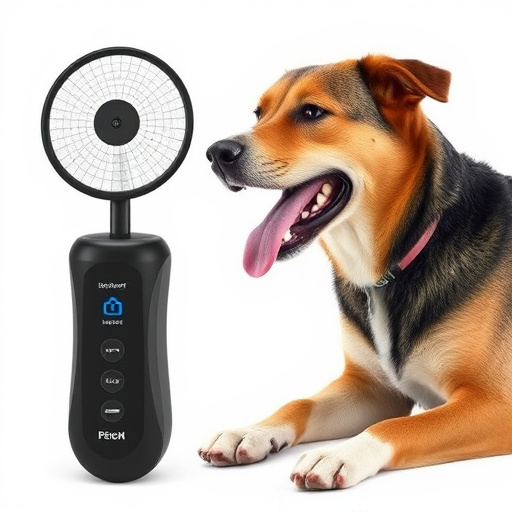Aggressive dog behavior demands tailored management. Ultrasonic dog repellents, emitting high-frequency sounds, offer a humane solution. Stationary devices provide consistent protection for confined spaces like yards, while mobile repellents offer versatility for dynamic environments. Both have pros and cons; stationary units are easy to install but may require maintenance, while mobile repellents offer flexibility but need constant adjustment. The ideal choice depends on the pet's behavior, environment, and owner's lifestyle in the Stationary Vs Mobile Dog Repellent Comparison.
“Tired of dealing with an aggressive pet dog? Discover a humane solution with ultrasonic dog deterrents—a game-changer for managing your pup’s behavior. This comprehensive guide delves into the science behind these devices, exploring their effectiveness and safety as well as a stationary vs. mobile repellent comparison. Learn how to choose the best option for training your dog while maintaining a peaceful environment. By understanding the root causes of aggression, you can take control and create a harmonious home.”
- Understanding Aggressive Dog Behavior: Root Causes & Solutions
- What Is an Ultrasonic Dog Deterrent? How Does It Work?
- Stationary vs Mobile Repellents: Pros and Cons Compared
- Effectiveness, Safety, and Training: A Comprehensive Look
Understanding Aggressive Dog Behavior: Root Causes & Solutions
Aggressive dog behavior can stem from various root causes, including fear, anxiety, territoriality, or past traumatic experiences. Understanding these triggers is crucial in addressing and managing such behavior effectively. One common approach to deterring aggressive dogs involves the use of ultrasonic dog repellents, which emit high-frequency sound waves that are unpleasant to canines but harmless to humans and pets.
When considering a stationary vs. mobile dog repellent comparison, it’s essential to recognize their distinct advantages. Stationary devices are ideal for confined spaces or areas where consistent deterrence is needed, such as yards or patios. In contrast, mobile repellents offer flexibility, making them perfect for outdoor walks or multi-purpose use in various locations. Both types can be effective when tailored to the specific needs and behaviors of aggressive pets.
What Is an Ultrasonic Dog Deterrent? How Does It Work?
An ultrasonic dog deterrent is a device designed to control and prevent unwanted canine behavior through the emission of high-frequency sound waves. Unlike traditional repellents that rely on scent or taste, this modern approach utilizes sound as its primary tool for deterrence. When activated, the device emits an inaudible frequency range to dogs, creating a discomfort that encourages them to stay away from the treated area.
The key to its effectiveness lies in the principle of stationary versus mobile dog repellents. Unlike moving devices like sprayers or motion-activated systems, ultrasonic deterrents maintain a consistent presence, emitting their signal steadily. This stability allows them to establish a defined boundary, effectively training dogs to avoid specific zones. As a result, they offer a humane and environmentally friendly alternative for addressing aggression, barking, or territorial issues in pets.
Stationary vs Mobile Repellents: Pros and Cons Compared
In the ongoing debate over how to manage aggressive pet behavior, the choice between stationary and mobile dog repellents offers distinct advantages and drawbacks. Stationary repellents, often in the form of ultrasonic devices or scent-based barriers, provide a consistent presence, emitting sounds or scents that deter dogs from specific areas. Their pros include ease of installation, compactness, and the ability to target particular problem zones. However, they might require regular maintenance, and their effectiveness can be limited by external factors like weather conditions or obstructions that block the signal.
On the other hand, mobile repellents, such as handheld devices or spray-based solutions, offer versatility in terms of reach and application. They are ideal for managing dynamic situations, like walks or visits to new environments, where a stationary system might be impractical. Yet, their portability also means constant adjustment and reapplication, while their effectiveness can vary based on the user’s consistency. The choice between these options ultimately hinges on factors like the pet’s behavior patterns, the environment’s size and accessibility, and the owner’s lifestyle.
Effectiveness, Safety, and Training: A Comprehensive Look
When it comes to addressing aggressive pet behavior, ultrasonic dog deterrents have gained popularity as a non-lethal alternative to traditional training methods. These devices emit high-frequency sound waves that are unpleasant to dogs, encouraging them to leave the area. However, understanding their effectiveness alongside safety considerations is paramount. A crucial comparison lies between stationary and mobile options. Stationary units are ideal for confined spaces like yards, as they can consistently project sounds without users needing to relocate. In contrast, mobile deterrents offer versatility, allowing owners to move the device based on pet behavior changes or different environments.
Safety is a key aspect to consider. While ultrasonic repellents are generally safe for dogs and humans, certain factors must be addressed. The device’s frequency range should be suitable for all ages and breeds of dogs, as excessive noise levels can cause discomfort. Moreover, proper training techniques should accompany the use of such technology. Positive reinforcement during training sessions, combined with consistent application of the deterrent, has shown to yield better results. A comprehensive approach that blends effective technology with responsible training methods promises a more successful journey towards addressing aggressive pet behavior without harm.
When it comes to addressing aggressive pet behavior, an Ultrasonic Dog Deterrent can be a highly effective solution. By understanding both the root causes of aggression and how these devices operate, pet owners can make informed decisions. A stationary or mobile repellent each has its pros and cons (Stationary Vs Mobile Dog Repellent Comparison), so evaluating your specific needs and environment is crucial. With proper training and safety considerations, ultrasonic deterrents offer a humane and non-invasive approach to modifying behavioral patterns, ultimately enhancing the well-being of both pets and their owners.
